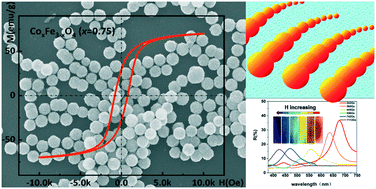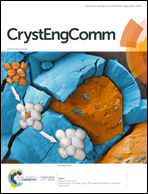Synthesis of monodisperse ferromagnetic CoxFe3−xO4 colloidal particles with magnetically tunable optical properties†
Abstract
Monodisperse CoxFe3–xO4 colloidal particles with uniform size and tunable composition have been prepared using a one-step hydrothermal method. Magnetic measurements reveal the typical ferromagnetic nature of the material with a saturation magnetization (Ms) of up to 75.6 emg g−1 and a coercivity (Hc) of 810 Oe at room temperature. The synthesized colloidal particles can be highly dispersed in aqueous solution and show quick magnetic response. Under the induction of an external magnetic field, the colloidal particles in suspension will be assembled into a colloidal array and selectively reflect visible light so that bright structural colors are generated throughout the visible wavelength range. This finding reveals that in addition to traditional superparamagnetic colloidal particles (such as Fe3O4 and MFe2O4 (M = Zn, Mg, Mn, and Ni)), hard magnetic CoxFe3–xO4 with relatively high coercivity can also be used as a candidate material for constructing magnetically responsive colloidal photonic crystals with potential applications in color displays, biological detection and anti-counterfeiting technology.



 Please wait while we load your content...
Please wait while we load your content...